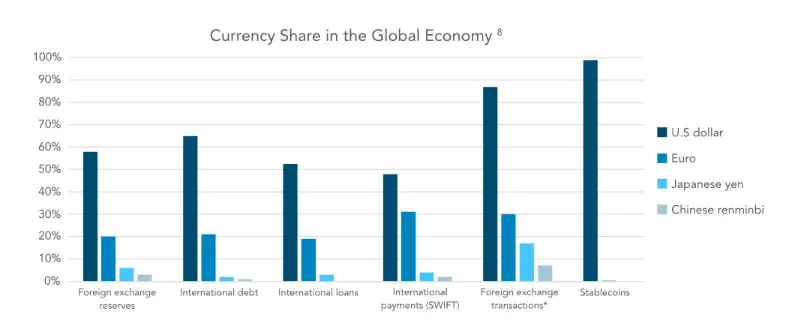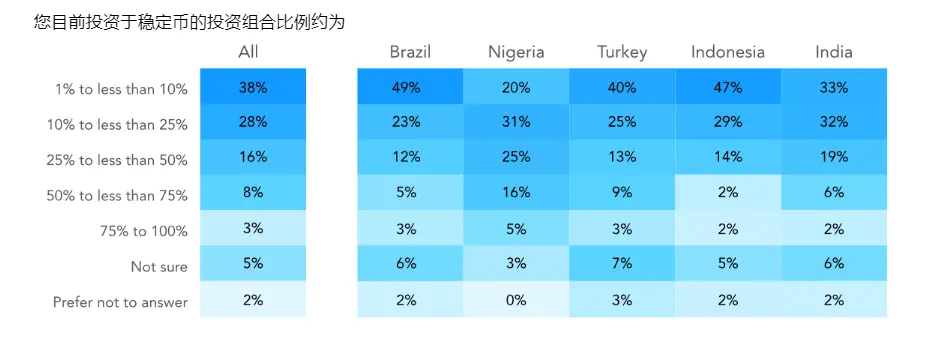Interpretation of Visa Stablecoin Survey Report: Non-speculative Use Cases Emerge in Emerging Countries, Nearly Half of Users Use It to Store US Dollars
Author: Deep Tide TechFlow
The business of stablecoins is attracting more and more traditional enterprises to participate.
For example, Visa, a giant in settlement and payment in the Web2 world, is gradually extending its business into the stablecoin field.
Leveraging its existing business network, Visa currently supports over 50 wallet partners, enabling quick and easy issuance of Visa credentials, allowing stablecoin users to make fast and secure payments at over 130 million merchants worldwide.
At the same time, Visa is also trialing the use of stablecoins like USDC to expand the settlement capabilities of global issuing banks and acquiring banks, providing greater flexibility for modern government bonds.
How do such industry giants view today's stablecoin market?

Recently, Visa, in collaboration with Castle Island (venture capital), Brevan Howard Digital (asset management), and Artemis (on-chain data analysis), released a research report on the stablecoin market, investigating the current macro market, supply-demand relationship, and adoption of stablecoins.
Notably, the report focuses on five emerging countries: Brazil, Turkey, Nigeria, India, and Indonesia, combining user survey results with on-chain estimates, as well as qualitative insights from companies operating in these markets, to gain a comprehensive understanding of global stablecoin usage.
Deep Tide TechFlow has interpreted and organized this report, highlighting the key points as follows.
Key Conclusions
- On-chain data proves that the usage of stablecoins is increasing, whether in terms of monthly active addresses, total supply, or settlement value;
- Stablecoins have established themselves as a meaningful medium of settlement, comparable to established transfer networks;
- Stablecoins are no longer just used for crypto speculation. 47% of surveyed cryptocurrency users listed saving in dollars as their stablecoin goal, 43% mentioned efficient currency exchange, and 39% indicated earning yields;
- When asked about non-crypto stablecoin activities, the most popular uses of stablecoins are currency substitution (69%), followed by payment for goods and services (39%) and cross-border payments (39%);
- The vast majority (about 99%) of stablecoins are pegged to the dollar. When discussing U.S. stablecoin regulation, it is essential to acknowledge that a significant number of individuals and companies in emerging markets rely on these networks for savings, cross-border payments, remittances, and corporate cash management;
- When discussing the advantages of stablecoins, it is crucial to recognize the potential benefits of effectively accessing alternative hard currencies for billions of users in emerging markets;
The Market Situation of Stablecoins: Not Just for Speculation, A New "Savior" for Emerging Countries
Key Points
- Stablecoins are the "killer application" of cryptocurrency;
- The circulating value of stablecoins exceeds $160 billion, up from several billion in 2020. Over 20 million addresses are engaged in stablecoin transactions on public blockchains each month. In the first half of 2024, the settlement value of stablecoins surpassed $2.6 trillion;
- Based on the divergence between stablecoin activity and the crypto market cycle, it is clear that the adoption of stablecoins has transcended merely serving crypto users and trading use cases.

(The above image shows that even during periods of low trading volume on CEX and a downturn in the crypto market, the monthly sending addresses for stablecoins have continued to increase, indicating that the adoption of stablecoins is not limited to crypto trading/speculation.)
Especially in emerging markets, they are used for currency substitution (escaping volatile or depreciating local currencies), as a dollar-based bank account alternative, B2B and consumer payments, earning various forms of yields, and trade settlements. In countries with high inflation where dollar banking is absent or hard to access, or where the ability to use fiat transaction networks is poor or costly, stablecoins are particularly attractive.
Macro Data Overview: The Strong Rise of Stablecoins, Gradual "Dollarization" of Blockchain
Key Points
- Since 2017, the total supply of stablecoins has grown rapidly, peaking at around $192 billion in March 2022;
- The collapse of Terra's UST and credit tightening suppressed crypto-native yields, reducing trading volumes; after the credit crisis essentially ended, stablecoin supply began to recover in December 2023 as major crypto assets started to rebound before the approval of Bitcoin ETFs in the U.S.;
- As crypto-native yields and sovereign yields rise, certain stablecoin issuers have begun to experiment with models to pass yields to holders, either programmatically on-chain or through third-party yield-sharing arrangements;
- Notably, Ethena's USDe is a synthetic dollar token whose yields come from arbitrage between Bitcoin and Ethereum futures against spot, ranking fourth with a supply exceeding $3 billion.

- USDT (originally issued on the Bitcoin Omni protocol) was the first stablecoin to achieve breakthrough success, and Tether has remained the largest and most widely used stablecoin.
- With the significant growth of Circle's USDC, Tether's dominance fell below 50% in 2022. Since then, Tether's supply market share has recovered and stabilized around 70%.

- In 2023, transactions worth $3.7 trillion were conducted using these stablecoins.
- By mid-2024, transactions worth $2.62 trillion have already been made with them. If this momentum continues in the second half of the year, the total for the year could reach $5.28 trillion.
- Although the overall cryptocurrency market was not very prosperous in 2022 and 2023 (with many crypto prices falling and exchange trading volumes decreasing), the usage of these stablecoins has been steadily increasing.

- As of June 2024, the most popular blockchains by settlement value are Ethereum, Tron, Arbitrum, Coinbase's Base, Binance Smart Chain, and Solana.
- The most popular blockchains for sending stablecoins are Tron, Binance Smart Chain, Polygon, Solana, and Ethereum. Ethereum's fee burden is generally higher, which means that compared to Tron or Binance Smart Chain, there are often fewer transaction addresses and transactions, but Ethereum remains the leader in settlement value.

- The "dollarization" story of blockchain is emerging --- historically, Bitcoin and Ethereum have been the primary mediums of exchange on public blockchains, but stablecoins --- and almost entirely dollar-pegged stablecoins --- have steadily gained market share.

- Among fiat currency-pegged options for stablecoins, the dollar is overwhelmingly popular, followed by the euro, which had a supply of $617 million as of June 2024, accounting for 0.38% of the entire stablecoin market.

- The dollar is the global reserve currency, but it does not dominate any other use category as it does in stablecoins.
The voices advocating for alternative currencies as stablecoins have existed for years but have yet to gain attention. The overwhelming dominance of the dollar in the stablecoin space likely reflects the fact that most jurisdictions have not set any local barriers to using dollar-pegged stablecoins, and users simply prefer the most liquid tokens, such as USDT and USDC.

Micro Adoption Survey: Nearly Half of Users Aim to "Save in Dollars" with Stablecoins
Survey Methodology
Approximately 500 people from Nigeria, Indonesia, Turkey, Brazil, and India were surveyed, with a total sample size of 2,541 adults.
The sample was limited to existing crypto users to better understand how these individuals interact with stablecoins.
Key Findings
While the most common motivation for using stablecoins is to acquire cryptocurrency (50%), non-crypto uses, such as saving in dollars (47%), earning yields (39%), and trading purposes are also popular.
Stablecoins are preferred over dollar banking due to their yields, efficiency, and lower likelihood of government intervention.
57% of users reported an increase in stablecoin usage over the past year, and 72% believe they will increase their stablecoin usage in the future.
The primary reason for preferring Tether is its network effect, followed by user trust, liquidity, and its track record compared to other stablecoins.
In non-trading use cases, currency exchange (to dollars) is the most frequently reported activity, followed by payment for goods, cross-border payments, and paying or receiving salaries.
Ethereum is the most popular blockchain among sampled users, followed by Binance Smart Chain, Solana, and Tron.
The most popular wallet among respondents is Binance (exchange), followed by Trust Wallet, Metamask, Coinbase Wallet, crypto.com, and Phantom Wallet. There is a noticeable long-tail effect in the wallet usage survey.
Survey Details

Among stablecoin users in the sample, the most popular goal is trading cryptocurrencies or NFTs, but other non-crypto uses are also significant.
Overall, 47% of respondents indicated that one of their primary goals is to save in dollars, 43% mentioned better currency exchange rates, and 39% indicated earning yields.
The findings are clear: in the surveyed countries/regions, non-crypto use accounts for a substantial share of stablecoin usage patterns.
The most popular uses are currency exchange, followed by shopping and cross-border transactions. Notably, the majority of respondents from all countries/regions in the sample reported having used stablecoins for non-crypto trading use cases.

At the national level, the penetration of stablecoins in users' portfolios varies by country.
Nigerians are far above the rest of the sample, followed by Turkey and India. Among Indian users, respondents from the wealthiest group also reported holding a larger share of stablecoins in their financial portfolios.

Nigerian users have the highest affinity for stablecoins among the surveyed countries. Nigerian users trade most frequently, stablecoins account for the largest share of respondents' portfolios, they report the highest share of non-crypto trading use cases for stablecoins, and they have the highest self-reported understanding of stablecoins.
In Turkey, the most common goal is to earn yields, followed by trading cryptocurrencies. For Indonesians, better currency exchange rates are the priority, followed by trading cryptocurrencies and saving in dollars. For Nigerians, saving in dollars is the primary goal, followed by trading cryptocurrencies and obtaining better currency exchange rates.
The income results in India are very clear: wealthier respondents have a higher penetration of stablecoins in their portfolios, they are more likely to use stablecoins for a wider range of use cases, including non-crypto use cases, and they are more likely to trust stablecoins over bank accounts.

Age Factor: The New Favorite of Young People
Younger individuals have a higher usage rate of stablecoins. They are more likely to experiment with various stablecoins and maintain a higher share of stablecoins in their overall financial portfolios.
In terms of frequency of converting fiat currency, 34% of young people (aged 18-24) do so weekly, 38% monthly, while the oldest respondents (55+) have a weekly rate of 15% and a monthly rate of 46%.
Among all non-crypto use cases, stablecoins are used more frequently by younger age groups: for paying for goods/services, remittances, and receiving salaries in stablecoins.
Tether is More Popular, but Not Irreplaceable

Many report sticking with USDT out of habit, but they would switch to alternative stablecoins if a consensus emerged around them in their networks.
Some users also report that they would switch from Tether if it were banned or faced government intervention. Additionally, the lack of yields is a potential reason for switching to alternative stablecoins.
Wallet Usage: Ethereum is Expensive but Widely Used
Ethereum is the most popular blockchain network across all regions, followed by Binance Chain, Solana, and Tron.
The results are surprising, as Ethereum's fees have always been too high for smaller retail payments.
The most popular non-custodial wallets are Trust Wallet, MetaMask, and Coinbase Wallet.
Half of the respondents indicated using the Binance exchange as a wallet, more than any other non-custodial wallet. Notably, 39% of surveyed Nigerians admitted to using Phantom Wallet.












